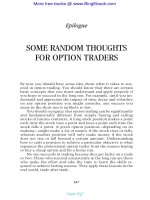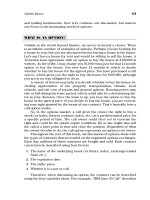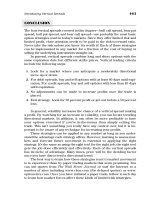101 Creative Problem Solving Techniques: The Handbook of New Ideas for Business
Bạn đang xem bản rút gọn của tài liệu. Xem và tải ngay bản đầy đủ của tài liệu tại đây (4.03 MB, 241 trang )
101 CREATIVE
PROBLEM
SOLVING
TECHNIQUES
THE HANDBOOK
OF NEW IDEAS
FOR BUSINESS
sr
191
cc 'SS
ISBN 1-883629-00-4
5 795
9
81
83
62
07
"An approach to innovation that allows you to get your hands on it
and actually do something in your organization. Lots of great
practical (and fun) techniques for generating ideas. The best
-
how-to" book on innovation I've ever seen."
Phil Harris, Vice President and
General Manager, of Paperboard
James River
Corporation
"In business, we find an increasing rate of change accompanied by
greater complexity. Survival demands creative solutions. Higgins'
book is a convenient, practical reference which describes time
tested techniques that all of us can use. Humorous, timely
examples of how companies have used these techniques make the
book very useful."
Allan Nagle
Former CEO
of
Tupperware
"You'll find Higgins' book engaging, easy to read, and very practical.
He's right on target when he states that innovation is the key for
an organization to gain or maintain a competitive edge."
Valerie Oberle
Vice President for Disney University
for Walt Disney World
"Paradigms broken. Dr. Higgins' book gives readers a new road
map to creatively using quality processes. Thought provoking,
practical, and impactful. This is the kind of easy reference guide I
have been searching for, for years. It is an innovative toolbox for
those involved with project planning or building high performance
work teams."
Rod Waddell, Quality Consultant
President
Dynamic Resources, Inc.
Business, Self Development
$17.95
"An approach to innovation that allows you to get your hands
on
it
and actually do something in your organization. Lots of great
practical (and fun) techniques for generating ideas. The best
"how-to" book on innovation I've ever seen."
Phil Harris, Vice President and
General Manager, of Paperboard
James River Corporation
"In business, we find an increasing rate of change accompanied by
greater complexity. Survival demands creative solutions. Higgins'
book is a convenient, practical reference which describes time
tested techniques that all of us can use. Humorous, timely
examples of how companies have used these techniques make the
book very useful."
Allan Nagle
Former CEO of Tupperware
"You'll find Higgins' book engaging, easy to read, and very practical.
He's right on target when he states that innovation is the key for
an organization to gain or maintain a competitive edge."
Valerie Oberle
Vice President for Disney University
for Walt Disney World
"Paradigms broken. Dr. Higgins' book gives readers a new road
map to creatively using quality processes. Thought provoking,
practical, and impactful. This is the kind of easy reference guide I
have been searching for, for years. It is an innovative toolbox for
those involved with project planning or building high performance
work teams."
Rod Waddell, Quality Consultant
President
Dynamic Resources, Inc.
Business, Self Development
ISBN 1-883629-00-4
$17.95
1
1
1 1 1
1
51795
9 781883629007
bool,
i'ada
►
le at a SpeCial
diSCOUnl
when ordered in bulk
guard it se, 1 or inlOrmation, contact New Management Publishing
tomvany, Inc 400 N. New York Avenue, Suite 215, Winter Park,
l
it
►
.32789.
DEVELOPMENTAL EDITOR: Carolyn D. Smith
PRODUCTION MANAGER: Susan Novotny
DESIGNER: Keri Caffrey
ILLUSTRATOR: Keri Caffrey
WORD PROCESSOR: Susan Crabill
Copyright ©
1994 James M. Higgins
Printed in the United States of America
All rights reserved. No part of this book may be reproduced or
transmitted in any form or by any means, electronic or mechanical,
including photocopying, recording, or any information storage and
retrieval system, without permission in writing from the publisher.
New Management Publishing Company, Inc.
400 North New York Avenue, Suite 215
Winter Park, Florida 32789
Publisher's Cataloging-in-Publication Data
Higgins, James M.
101 Creative Problem Solving Techniques: The Handbook of
New Ideas for Business /James M. Higgins.
p. cm
.
Includes bibliographical references and index.
ISBN 1-883629-00-4
1. Problem solving. @. Organizational change. I. Title. II. Title:
One hundred and one creative problem solving techniques.
HD30.29.H54 1994
658.4'063
QB193-22664
93-8702
P-CIP
Printing 3456789
This book is dedicated to my wife
Susan, and my mother, Edna, for
their loving encouragement of my
creativity and innovation.
Businesst'. and their managers, professional staff, team leaders
and other employees are confronted with a host of challenges
as they approach the twenty first century. Change is occuring
at an accelerating rate. The number of competitors is increas-
ing dramatically. Business is globalizing. New technology is
being introduced at a rapid pace. The workforce is increasingly
diverse. There is a scarcity of certain resources, including highly
skilled workers. There is a transformation occuring from an
industrial to a knowledge based society. Economic and market
conditions are increasingly unstable, especially on a global ba-
sis. Constituents are more demanding. And finally, the entire
business environment is becoming more complex.
To meet these challenges and the opportunities they create,
businesses are embracing creative problem solving and inno-
vation as never before. To achieve effective and efficient levels
of creative problem solving and the innovation which results,
an organization must improve the creativity of its work groups
and individuals, and it must create the right kind of organiza-
tional culture which will turn that creativity into innovation.
One of the key ways in which individuals and groups can im-
prove their creativity is through learning creativity processes,
techniques that take advantage of innate intuitive and creative
abilities, techniques that channel these abilities to create new or
enhanced products or services, or create more effective and ef-
ficient organizational processes. This book describes the basic
creative problem solving (CPS) model and then describes 101
techniques for unleashing individual and group creativity.
These techniques follow the CPS model.
Managers, professionals, team leaders, and any other employee
interested in improving his or her job performance or that of
the work group, or for that matter, the entire company, will find
this book beneficial. This book is readily useable in company
training programs. Organizational creativity training programs
have grown rapidly in recent months, and this book is designed
to meet the needs of such programs.
011,1
this smile author, both to be
published in
W ,
tin other two aspects of increasing organizational
alum.
Innovate
Evaporate: Test and Improve Your
al ion's IQ—Its Innovation Quotient,
identifies the set of
(.1 LI deristics common to the innovative organization. It pro-
v ides numerous descriptions of organizational programs for
achieving high levels of innovation performance.
Escape from
the Maze: Increasing Personal and Group Creativity
provides a
roadmap for improving individual and group creativity per-
formance. For individuals, this means learning to overcome
the psychological barriers to creativity imposed by society and
the organization, and learning how to increase levels of intu-
ition. For the group, this means learning proper group dynam-
ics to take advantage of group creativity processes. Order forms
for the books can be found in the latter pages of this book.
THANKS
No book is the work of the author alone. I want to thank sev-
eral people for their critical inputs into this book. First, Keri
Caffrey, one of the most creative people I've ever known, has
illustrated and designed this book in an artful yet fun manner
for the reader. Susan Crabill spent several hundred hours work-
ing through numerous drafts, all done with great patience.
Susan Novotny managed to put all of this together in the final
hectic stages of production. Carolyn Smith, my developmental
editor on two of my college texts, did an outstanding job of
making this book user friendly. Several hundred MBA students
provided important feedback about the book, and how to make
it more useable. My business reviewers, Phil Harris, Vice Presi-
dent and General Manager of Paperboard for the James River
Corporation, Allan Nagle, former CEO of Tupperware, Valerie
Oberle, Vice President, Walt Disney Companies, and Rod
Waddell, quality consultant and President of Dynamic Resource
Development, Inc., have provided important insights about the
potential impact of this book. And finally, my wife Susan, has
provided tremendous support during this lengthy writing and
publication process.
4'?
TABLE OF CONTENTS
PREFACE
v
THANKS
vi
Chapter
I
INNOVATE OR EVAPORATE
INNOVATION AND CREATIVITY
3
THE "FOUR P'S" OF CREATIVITY AND INNOVATION
5
THE FOURTYPES OF INNOVATION
9
REFERENCES
15
Chapter 2
THE
CREATIVE PROBLEM SOLVING
PROCESS
CREATIVE PROBLEM SOLVING
18
Analyzing the Environment
20
Recognizing a Problem
21
Identifying the Problem
21
Making Assumptions
22
Generating Alternatives
24
Choosing Among Alternatives
25
Implementation
26
Control
26
BUILDING CREATIVITY INTO PROBLEM SOLVING
28
101 CPSTECHNIQUES
29
REFERENCES
33
VII
Chapter- 3
RLATIVE TECHNIQUES FOR
ANALYZING
THE ENVIRONMENT,
RECOGNIZING & IDENTIFYING
PROBLEMS,
AND MAKING ASSUMPTIONS
TECHNIQUES FOR ANALYZING THE ENVIRONMENT
36
COMPARISON AGAINST OTHERS: BENCHMARKING, BEST
PRACTICES,AND RACING AGAINST PHANTOM
COMPETITORS
37
212.
HIRE FUTURISTS AND OTHER CONSULTANTS
37
3/3.
MONITOR WEAK SIGNALS
37
4/4.
OPPORTUNITY SEARCHES
38
TECHNIQUES FOR RECOGNIZING PROBLEMS
38
5/1.
CAMELOT
40
6/2.
CHECKLISTS
40
7/3.
INVERSE BRAINSTORMING
40
8/4.
LIMERICKS AND PARODIES
40
9/5.
LISTING COMPLAINTS
41
1016.
RESPONDING TO SOMEONE ELSE
41
11/7.
ROLE PLAYING
41
12/8.
SUGGESTION PROGRAMS
42
13/9.
WORKOUTS AND OTHER GROUP APPROACHES
42
TECHNIQUES
FOR IDENTIFYING PROBLEMS
43
14/1.
BOUNCE IT OFF SOMEONE ELSE
44
15/2.
CONSENSUS BUILDING
44
16/3.
DRAW A PICTURE OFTHE PROBLEM
44
17/4.
EXPERIENCE KIT
44
18/5.
FISHBONE DIAGRAM
45
19/6.
KING OFTHE MOUNTAIN
48
20/7.
REDEFINING A PROBLEM OR OPPORTUNITY
48
21/8.
REWRITE OBJECTIVES IN DIFFERENT WAYS
49
22/9.
SQUEEZE AND STRETCH
49
23/10. WHAT DO YOU KNOW?
51
24/11.
WHAT PATTERNS EXIST?
51
25/12.
WHY-WHY DIAGRAM
5I
TECHNIQUES FOR MAKING ASSUMPTIONS
54
26/1.
ASSUMPTION REVERSAL
54
ANALYZING THE ENVIRONMENT, RECOGNIZING AND
IDENTIFYING THE PROBLEM,
& MAKING ASSUMPTIONS
56
REFERENCES
57
VIII
rk0
INDIVIDUAL PROCESSES FOR GENERATING CREATIVE
ALTERNATIVES
61
27/1.
ANALOGIES AND METAPHORS
61
28/2.
ANALYSIS OF PAST SOLUTIONS
64
29/3.
ASSOCIATION
64
30/4.
ATTRIBUTE ASSOCIATION CHAINS
66
31 /5.
ATTRIBUTE LISTING
67
32/6 BACK TO THE CUSTOMER
69
33/7.
BACK TO THE SUN
70
34/8.
CIRCLE OF OPPORTUNITY
71
35/9.
COMPUTER PROGRAMS
72
36/10.
DEADLINES
74
37/1 I .
DIRECT ANALOGIES
75
38/12.
ESTABLISH IDEA SOURCES
78
39/13.
EXAMINE IT WITH THE SENSES
78
40/14.
THE FCB GRID
79
41/15.
THE FOCUSED-OBJECT TECHN IQUE
82
42/16.
FRESH EYE
84
43/17.
IDEA BITS AND RACKING
84
44/18.
IDEA NOTEBOOK
84
45/ 19.
INPUT-OUTPUT
85
46/20.
LISTENING TO MUSIC
86
47/21.
MIND MAPPING
87
48/22.
NAME POSSIBLE USES
90
49/23.
THE NAPOLEON TECHNIQUE
91
50/24.
ORGANIZED RANDOM SEARCH
91
51/25.
PERSONAL ANALOGIES
92
52/26.
PICTURE STIMULATION
93
53/27.
PRODUCT IMPROVEMENT CHECKLIST
94
54/28.
RELATEDNESS
95
55/29.
RELATIONAL WORDS
95
56/30.
REVERSAL-DEREVERSAL
100
57/31.
ROLLING IN THE GRASS OF IDEAS
10 I
58/32.
THE 7 x 7 TECHNIQUE
102
59/33.
SLEEPING/DREAMING ON IT
104
60/34.
THE TWO-WORDS TECHNIQUE
105
61/35.
USING THE COMPUTER TO STIMULATE CREATIVITY
106
62/36.
VERBAL CHECKLIST FOR CREATIVITY
106
63/37.
VISUALIZATION
110
64/38
WHAT IF.
110
A 1 INA1 NO1 E.
1 10
A QUICK GUIDE TO MY FAVORITE TECHNIQUES FOR
GENERATING ALTERNATIVES*
112
REFERENCES
113
Chapter 5
GROUP TECHNIQUES FOR
GENERATING ALTERNATIVES
ADVANTAGES AND DISADVANTAGES OF GROUP
DECISION MAKING
116
GROUP PROCESSES FOR GENERATING CREATIVE
ALTERNATIVES
118
65/1.
BRAINSTORMING
118
66/2.
BRAINWRITING
125
67/3.
BRAINWRITING POOL
126
68/4.
BRAINWRITING 6-3-5
129
69/5.
CREATIVE IMAGING
I29
70/6.
CREATIVE LEAPS
130
7117.
CREATIVITY CIRCLES
131
72/8.
CRAWFORD SLIP METHOD
132
73/9.
DELPHI TECHNIQUE
135
74/10.
EXCURSION TECHNIQUE
136
75/11.
GALLERY METHOD
139
76/12.
GORDON/LITTLE TECHNIQUE
140
77/13.
GROUP DECISION SUPPORT SYSTEMS
140
78/14.
IDEA BOARD
142
79/15.
IDEA TRIGGERS
142
80/16.
INNOVATION COMMITTEE
142
81/17.
INTERCOMPANY INNOVATION GROUPS
143
82/18.
LION'S DEN
143
83/19. LOTUS BLOSSOM TECHNIQUE, OR THE MY (MATSUMURA
YASUO) METHOD
144
84/20.
MITSUBISHI BRAINSTORMING METHOD
146
85/21.
MORPHOLOGICAL ANALYSIS
147
86/22.
NHK METHOD
149
87/23.
NOMINAL GROUP TECHNIQUE
150
88/24.
PHILLIPS 66 (DISCUSSION 66)
154
89/25.
PHOTO EXCURSION
154
90/26.
PIN CARD TECHNIQUE
155
91/27.
SCENARIO WRITING
155
92128.
SIL METHOD
160
93/29.
STORYBOARDING
161
x
94/30
4
,YNI ( II(
1/1
95/31
IAKI IIVI
178
96/32.
1 K) M1.1110D
179
A FINAL NOTE
180
REFERENCES
181
Chapter
6
CREATIVE TECHNIQUES FOR
CHOOSING AMONG THE ALTERNATIVES,
IMPLEMENTATION, AND CONTROL
CHOOSING AMONG ALTERNATIVES
186
97/I.
THE SCREENING MATRIX FOR IDEAS
187
98/2.
DOT VOTING
190
IMPLEMENTATION
191
99/I.
HOW-HOW DIAGRAM
191
100/2.
BE AWARRIOR WHEN SELLING YOUR IDEAS
193
I 01/3.
FORCE-FIELD ANALYSIS
194
ADDITIONAL ADVICE ON IMPLEMENTATION
198
CONTROL
204
REFERENCES
206
Chapter 7
USING THE TECHNIQUES
USINGYOUR INTUITION
207
USING THE TECHNIQUES
208
REFERENCES
208
APPENDIX I -A Quick Guide to the Processes
209
INDEX
215
ABOUT THE AUTHOR
223
X
I
cif
Innovation
INN
V
TE OE EVAPORATE
Profit, thy name is creativity.
— Business Week
When giant PC chipmaker Intel was confronted with new
and unusually tough competitors that used clones of its chips
to compete on price, CEO Andrew Grove turned to innova-
tion. Intel launched an accelerated schedule for new-product
development that produced the 386, 486, and Pentium chips
and left competitors in the dust.'
When Johnson & Johnson, the health care and consumer
products conglomerate, found itself at a cost disadvantage
compared to competitors, it launched a program to develop
innovative processes that would cut overhead costs. For
example, CEO Ralph Larsen created customer support cen-
ters, employee teams working on customer sites to facilitate
distribution and ordering. The teams eliminated overlap-
ping services in most of the firm's 166 businesses.
2
When Nordstrom, the Seattle-based department store chain,
analyzed its markets, it realized that providing high levels
of customer service would be an innovative marketing ap-
proach in the discount-oriented retail industry. That strat-
egy worked extremely well, giving Nordstrom an edge in a
rapidly changing marketplace.'
101
CREATIVE
PROBLEM
SOLVING
TECHNIQUES
%% 11.11
hitPackard realized that
it was at a competitive
ingloba 1 markets beca use bureaucratic require-
!' wilt were
n
v the product development process, it re-
(1( iroied its organizational
structure to speed up product
development.'
Surviving and prospering in business have never been easy.
There
are always problems to be solved and opportunities
to be
taken advantage of. But during the next few years,
from. now through the first decade of the 21st century, busi-
ness organizations, their managers, and their other employ-
ees will be confronted with a number of strategic challenges
unmatched in business history. The primary challenges are
these:
5
1.
Every facet of business is changing at an
accelerating rate.
2.
Competition is increasing.
3.
Business is becoming increasingly global
in scope.
4.
New technologies are being introduced at
a breathtaking rate.
5.
The composition of the
work force is changing, as
are its members' values and
expectations.
6.
There are increas-
ing shortages of re-
sources ranging
from water to
skilled employees.
7.
The U.S. economy is
being transformed from an industrial
economy to one based on knowledge and in-
formation.
Market and economic conditions throughout
the world are extremely unstable.
. Constituents, such as shareholders and environ-
mentalists, are making greater demands on the
organization.
10. Not only is the business environment changing rapidly,
but it is becoming much more complex.
Asa consequent e tit ille. challenge.
facet Of host
ness, from overall strategy to daily operations, is lull of new
problems and opportunities.
And the task of just "doing
business" remains. This in itself is difficult enough without
all of these additional burdens. How can a business or any
part of it survive and prosper in the face of such challenges?
By
innovating!
Virtually every leading authority on business,
including Fortune 500 CEOs, researchers, and consultants, agrees
that there is only one way firms can cope with all the challenges
confronting them in the 1990s, not to mention those they'll have to
face in the twenty-first century. They must be innovative.' Intel,
Johnson & Johnson, Nordstrom, and Hewlett-Packard all inno-
vated in order to survive and prosper.
Innovate or evaporate.
INNOVATION AND
CREATIVITY
Innovation is how a firm or an indi-
vidual makes money from creativity.
Organizations,
their managers,
and other employees seek to cre-
ate original ideas and concepts
that will end up as innovations,
such as new or enhanced products
or services, processes that in-
crease efficiency, highly competi-
tive marketing campaigns, or su-
perior management. The process of
generating something new is known
as origination.
Something original is something_
new, something that didn't existi
before. Creativity is the proce§§'
-
ofIetterating som
new that has value. There are many original ideas and con-
cepts, but some may not have value and hence may not be
considered creative. A
creation
is something original that
has value.
Innovation
is the process of creating something new
that has
significant value to an individual, a group, an organization,
101
CRE"TIVE
PROBLEM
SOLVING
TECHNIQUES
3
11iill'AIN,
SOCIet
t
'.
y
An
innovation
thus is a !cation
th.lt ha iyouticant value.
I
11( A. distinctions
may seem superficial and academic, but
1110V a re not. This is so for several reasons, all of which are
related to the ultimate goal of innovation. First, you need to
learn how to tell whether the ideas you generate are creative
or merely original. Original ideas just aren't enough. Sec-
ond, to be innovative you need to go beyond merely being
creative. You need to know whether the ideas you generate
have the potential for significant value, that is, the potential
to become innovations. Finally, firms as well as individuals
must learn to
turn creations into
innovations. Unfortunately,
while U.S. firms and their employees are not nearly as cre-
ative as they should be, their performance record is even
worse when it comes to
turning creations into
innovations.
On average, only one idea in ten that is developed in a labo-
ratory ever gets to market.' As a result, the global competi-
tive positions of U.S. firms have eroded significantly in re-
cent years and will continue to do so unless those firms be-
come more innovative.
Moreover, in meeting the other strategic challenges and in
"doing business" every day, firms will not be as effective or
efficient as they should be if they cannot be innovative. Solv-
ing problems and pursuing opportunities require solutions,
many of which may be unique to the specific situation. There-
fore, creativity and the resultant innovation are fundamen-
tal to the survival and prosperity of the firm.
Creativity, the Springboard to
Innovation
Before
we can have innovation, we must have creativity.
Expanding on our earlier definition,
creativity, then,
is the
skill to originate the new and to make the new valuable'
The new key word is
skill. Creativity is a skill. It is not some-
thing mystical, available only to a few. It can be learned by any-
one. Everyone possesses an innate capacity for creativity. But the
development of this capacity into a skill has been thwarted, for the
most part by parents, teachers, and bosses who provide and enforce
rules about what is acceptable behavior and because only a few
4
101(1
►
/
►
0
,
ilni
►
ilied
c 10111011
.
1/
is stilled
1 licrelote you Into.t
11(
.
1
to develop
to
unleash your untapped potential. This book
is about becoming more creative by learning techniques which en-
hance creativity in problem solving.
Creativity
can
be incremental, occurring in a series of small
progressive steps, such as the lengthy, painstaking research
that led to the development of polio vaccine. Conversely,
creativity can involve giant leaps of progress in which many
links in the evolutionary chain of concepts are hurdled by a
single effort. The main workings of Apple Computer's
Macintosh personal computer, a highly advanced system,
were a giant leap in technology at the time that they were
introduced.
The product of the creative effort need not be a tangible physi-
cal object. It may be an idea, an association of facts, an in-
sight, or a more effective or efficient process as well as a new
product or service. Each of these, when fully expressed and
functioning, has value.
For an organization, one of the critical steps in achieving in-
novation is developing the creative problem-solving skills of
its human resources—its managers, professionals, and other
employees. This book is designed to help in developing those
skills. The following chapters present 101 techniques or pro-
cesses for making problem solving more creative.
How the 4 P'S Fit
V
ITTEoko.Sv
Together with Creativity
and Innovation
Creativity can be increased both by learning techniques (pro-
cesses) and
by
increasing personal and group creativity. If
these occur within the right organizational culture (possi-
bilities), the result is innovation, as shown in Figure 1.1.
Creativity
Processes (Techniques)
Personal and Group
Creativity
Organizational Culture
Possibilities
Innovation
Product
4 Types of Innovation:
Product, Process,
Marketing, Management
menihers levels of personal and group'
■■
III 111)1 he able to cope with the ten strategic Lila I-
1, lent 1 f ied earlier, nor will it be able to solve its other
)1,
,
h1t.nls as well as it
might otherwise. It won't have the
products
it needs to sur-
Iv(' and prosper.
Figure 1.1 How the Four Ps Relate to Each Other
The Product
The product
is the result of the creation/innovation process.
It can be a physical product, a service, or an enhancement to
these; a process for increasing effectiveness and/or efficiency;
a more innovative approach to marketing, or a better way to
manage. To be a true creative product it must have value
and not just be original. To be innovative, it must have sig-
nificant value.
6
!low do von iletelmine what has potentially signiticant
value? Sometimes by analysis. Sometimes by intuition.
Value is relative, both to the value systems of the evaluator
and to the time during which the creation occurs. For ex-
ample, twelve Hollywood studios turned down the "Star
Wars" movie concept. Finally Twentieth Century Fox agreed
to take the risk and made the most financially successful
movie of all time. Similarly, some inventors and their inves-
tors offered to sell a new idea to
IBM,
General Motors,
DuPont, and several other major firms and were turned down
by all of them. Finally, they decided to build and market the
product themselves and became multimillionaires. The pro-
cess was photocopying. The company became Xerox.
9
Even successful entrepreneurs may misjudge the value of a
creation and, hence, its potential to become an innovation.
Victor Kiam, of Remington Razor fame, was once offered the
patent to Velcro for $25,000; he turned it down, believing it
had no future.
1
° Velcro products have sold for about $6 bil-
lion since their inception through 1988.
Later in this book, in Chapter 6,
some ways for determining
whether a product is innova-
tive will be discussed.
The Possibilities
For innovation to occur, the
pos-
sibilities
for creativity and in-
novation must exist. Regard-
less of your creative talents,
however great your knowledge
or skill, you will not be able to
create many innovations if you
are not functioning in a fa-
vorable situation. If the
organization's culture, in the broad-
est sense, does not support and even
require innovation, it is unlikely that innovation will occur.
The evidence indicates that organizational innovation results
from careful management of the organization's culture. This
can be readily understood in terms Of managing the
-
101
CREATIVE
PROPLEM
SOLVING
TECHWOUE
7
S'
►
"
ot
organizational success: strategy, structure,
•.h.m
(management), style
(leadership), staffing, skills
( 4
synergies), and
shared values (organizational cul-
ture). 'rile term
shared values
includes values related to the
other
six S's.
The Processes
Numerous techniques can be used to increase the creativity
of problem solving within an organization. Learning these
takes time and effort but you can master them. These pro-
cesses are directed at increasing creativity in all stages of the
problem-solving process. Chapters 3, 4, 5, and 6 review these
techniques for individuals and groups.
Personal and Group Creativity
Increasing personal creativity
involves a two-pronged effort:
increasing the use of the right brain (left brain if left handed)
to raise your levels of intuition,
and
freeing yourself from
socialization that has restricted your creativity. The latter
in-
cludes
not only resocializing yourself but also learning new
habits that will help you be more creative. The individual
functions within a group, so it is very important to properly
manage
group
dynamics in order to increase
creativity.
A
Trilogy of Books on Creativity and
Innovation
These four P's are the subjects of the three books in this se-
ries, which form a trilogy on creativity and innovation.
1.
101 Creative Problem Solving Techniques: The Handbook of
New Ideas for Business
reviews the
processes (techniques)
that individuals and groups can use in the creative prob-
lem solving process to make their use of it more creative.
2.
Innovate or Evaporate: Test and improve Your Organization's
IQ—Its Innovation Quotient
discusses both the
product
(the
four types of innovation, which are defined briefly in the
next section of this chapter) and the
possibilities
for
achieving the product.
8
1,5cape
1
1(m /lir
A
Id
JucreasmN
Pet.,
rlllrl
(
jou!
►
taiVity Poientral
ti iy,cusses
how to raise personal creativity
levels by working to improve intuition and by removing
barriers to creativity. Abrief discussion of how to improve
group dynamics in order to improve group creativity is
included.
THE FOURTYPES
OF INNOVATION
There are four principal types of inno-
vation (the product or result of the in-
novation effort): product, process, mar-
keting, and management.
12
I. Product innovation results in new
products or services, or enhance-
ments to old products or services.
The opening paragraph in this chap-
ter on Intel described a product in-
novation situation.
2. Process innovation results in im-
proved processes within the organi-
zation—for example, in operations,
human resources management, or fi-
nance. It focuses on improving effec-
tiveness and efficiency. The Johnson
4
1
ek
—
t !.
v4
t•
i!'
. ,
■
At
tt
.74
.
K
>
z
>
C)
K
i
M
'
4 I
•
4
1
6
.73
XI
C.
(-)
rn
cn
(SI
el
lb
I
AO!
I
—
1
P
OD
'4-111
,
to
,
!P
40.T.F
hi
:: _•
'73
0
rZ3
CI
i
K
n
7"
rrl
I
2
& Johnson example at the beginning of the chapter de-
scribed process innovation.
3.
Marketing innovation is related to the marketing func-
tions of promotion, pricing, and distribution, as well as to
product functions other than product development (for
example, packaging or advertising). Nordstroms, as de-
scribed in the third paragraph of this chapter, used ser-
vice as a marketing innovation.
4.
Management innovation improves the way the organi-
zation is managed. Hewlett-Packard's restructuring as dis-
cussed in the fourth paragraph of this chapter, was a man-
agement innovation.
9
•.t11,11
►
,,
organit,itions suggest that LI
n
tic!•ign
products and concepts, utilize their resourc ,s more
'sill., lively efficiently, market their products more cre-
t iv til
y„md
manage more effectively than less successful
organizations."
I t is creativity in managing all of the economic functions—
marketing, operations, finance, human resources, research
and development, and information management that sepa-
rates the truly successful companies from the less successful
ones. This can be seen in the discussion of Steelcase con-
tained in The Innovative Edge in Action 1.1. Note that
Steelcase is not a high-tech firm but operates in a basic manu-
facturing industry. An important lesson to learn from this
reading is that innovation is applicable to most jobs in all
kinds of industries.
The Innovative Edge in Action 1.2 describes Banc One, a ser-
vice firm that has found that innovation is necessary for sur-
vival. One lesson to learn from this reading is how innova-
tion can be applied in a service industry.
1
0
$
IMPROVING INNOVATION AT
STEELCASE
The pyramids of Egypt symbolize a culture that was
inert and set in its ways long before its eventual
demise. In Grand Rapids, Michigan, there is a pyra-
mid that symbolizes innovation and change. It is
the seven-story corporate development center of
Steelcase Company, an office furniture manufacturer with annual
sales of $1.6 billion.
Like many large, long-established American corporations, Steelcase
was making a stodgy and boring, though in this case, high-qual-
ity, product. Its closest competitor, Herman Miller, Inc., posed a
significant competitive threat because of its innovative spirit. Miller
is credited with creating the "open office" by using "systems fur-
niture" based on movable panels and furniture modules, and with
leading in the design of the "ergonomic" chair, which constantly
adjusts to changes in the user's position. In the 1970s, Steelcase
was just a follower.
Seeking to increase its dominance of the market, Steelcase has ac-
quired a number of small, high-profile design companies. It now
has a line of wooden office furniture and the rights to furniture
designed by architects Frank Lloyd Wright and Le Corbusier. It
has also rebuilt its physical facilities and reorganized its opera-
tions. The $111 million, 128-foot-tall pyramidal office building,
the most visible change, clearly demonstrates the company's new
commitment to innovation and style as well as quality.
Previously, the company's designers, engineers, and marketing per-
sonnel were housed in separate buildings. Now they are grouped
together to facilitate employee interaction, a necessary requirement
CONTINUES ON PAGE 12
11
NO
L
LDV
N
I
3D03
3
AI
IVAON
N









